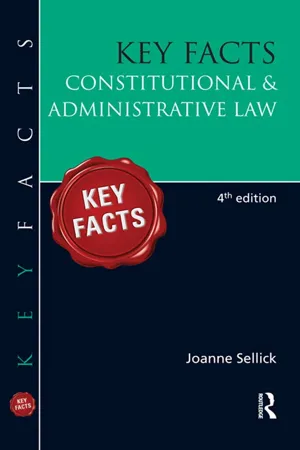![]()
1
Introduction to Constitutions
1.1 What is a Constitution?
1. A basic definition of a ‘constitution’ would be a body of rules regulating the way in which an organisation or institution operates. However, when the term ‘constitution’ is used in the context of a State’s constitution the definition is a little more complex.
2. The constitution of a State would be expected to:
establish the organs of government. Traditionally, this would consist of a body responsible for legislative functions; a body responsible for executive functions; and a body responsible for judicial functions;
allocate power between those institutions;
provide for the resolution of disputes on the interpretation of the constitution; and
establish procedures etc. for the amendment of the constitution.
3. The constitution therefore defines the relationship between the various institutions of the State (horizontal relationship) and that between the State and the individual (vertical relationship).
4. In a narrow sense, a constitution could be defined as a particular document (or series of documents) setting out the framework and principal functions of the organs of government in a particular State. Such a constitution will have, as Wade describes, ‘special legal sanctity’, meaning that it is the highest form of law in the State.
5. The majority of States have such a constitution, against which all other laws are measured. Should such laws fail to conform to the constitution, they may be declared unconstitutional by the courts.
6. The United Kingdom does not have a constitution that is the highest form of law since its constitutional principles can be amended by the passing of ordinary legislation – a consequence of the principle known as parliamentary supremacy (discussed in Chapter 4).
7. For this reason some have argued that the United Kingdom does not have a constitution. However, if we consider the wider definition of a constitution, which would be one that refers to the whole system of government, including all the laws and rules that regulate that government, we can clearly see that the United Kingdom does have a constitution (see, for example, F. Ridley).
1.2 The Classification of Constitutions
Constitutions can be classified in a number of different ways.
Codified (Written) or Uncodified (Unwritten)
1. This has been the traditional way of classifying a constitution. In many examples, constitutions are described as being written or unwritten. This is too simplistic an explanation. It is more accurate to describe constitutions as codified or uncodified.
2. A codified constitution is one where the constitution is enshrined in a single document or series of documents, as, for example, in the United States of America.
3. An uncodified constitution is one where the constitutional rules exist, and indeed may be written down in legislation, but there is no one source that can be identified.
4. The United Kingdom is the one of the few major countries in the world not to have a codified constitution. Consequently, the sources of the UK constitution are varied and include, for example, statute, common law and conventions. (The sources of the UK constitution are discussed in Chapter 2.)
5. In modern constitutional terms the desire to create a codified constitution will often be the result of some significant event, such as, for example:
revolution (e.g. France 1789);
reconstruction and/or redefinition of a State’s institutions following war/armed conflict (e.g. Germany, Iraq);
conferment of independence on a former colony (e.g. India, Australia, Canada);
creation of a new State by the union of formerly independent States (e.g. United States of America, Malaysia);
creation of a new State(s) by the break up of a former Union of States (e.g. States created by the break up of the former Republic of Yugoslavia).
6. The United Kingdom has suffered no major historical or political event that has necessitated the creation of a codified constitution. There have nevertheless been significant constitutional events such as, for example, the:
union of England and Scotland (1707) and Great Britain with Ireland (1800);
House of Lords crisis 1910;
abdication of the monarch 1936; and
joining the European Economic Community in 1973.
However, all of these events were dealt with by the passing of ordinary legislation such as, for example, the:
European Communities Act 1972.
Hence the United Kingdom’s constitution has evolved over time and remains uncodified.
Rigid or Flexible
1. This way of classifying a constitution was first suggested by Lord Bryce in the late 19th century.
2. A flexible constitution is one where all the laws of that constitution may be amended by the ordinary law-making process. The UK has a flexible con...



















